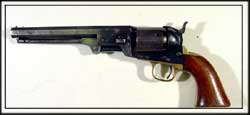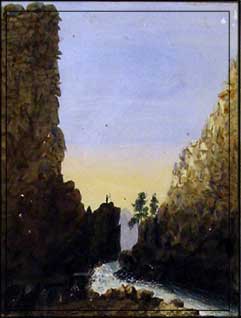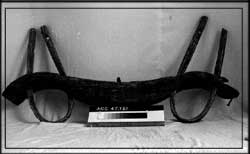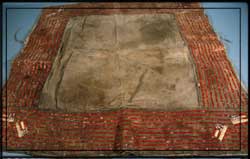|
Wyoming
State Museum
A Victim of
the Bozeman Trail
In the mid-1860s,
Indian tribes in what would become northern Wyoming were asked to sign
a treaty with the United States. By doing so, the tribes agreed to allow
travelers to move unopposed on the Bozeman Trail to the Montana gold
fields. However, while the treaty was being signed in June, 1866, several
American military units commanded by Colonel Henry Carrington were already
moving into Indian territory to build three forts along the trail.
The Lakota and
Cheyenne tribes were outraged. For months they harassed all traffic
on the trail, attacked woodcutting parties, ran off stock, and killed
anyone who strayed far from the forts. On December 21, 1866, Captain
William Fetterman disobeyed orders and led his troops into a well-planned
ambush near Fort Phil Kearny. Native American warriors led by Red Cloud,
Crazy Horse, and High-Back-Bone killed all 81 men in Fetterman's command.
This event became known as the Fetterman Fight.
This pistol belonged
to Colonel Carrington who was the commanding officer of Fort Phil Kearny at the time of the Fetterman
Fight. Carrington was blamed for the loss of Captain Fetterman and his
soldiers. It took the colonel twenty years to restore his reputation.
of Fort Phil Kearny at the time of the Fetterman
Fight. Carrington was blamed for the loss of Captain Fetterman and his
soldiers. It took the colonel twenty years to restore his reputation.
An inscription
on this pistol reads, "H. B. Carrington, Col. 18th Infantry, U.S.A."
Views
of the California Trail
Devil's Gate sketched
June 3, 1852.
This is indeed the most singular scenery on the whole route to California.
It seems as if the sweet water river had forced its way through this
immense pile of rocks - to the left the rock runs up some five or six
hundred feet almost perpendicular. One of the early emigrants, it is
said climbed up from behind it and was looking over
the precipice when he lost his balance and fell to the bottom. Part
way up in one of the cavities in the rock may be seen the bones of a
man's arm." - Cyrenius Hall
Twenty seven year
old artist Cyrenius Hall used a pencil to sketch this view of Devil's
Gate while traveling the California Trail in 1852. He added color to
it the following year. Hall recorded much of what he saw on his journey
including Native American burials, Chinese saloons and camps, sawmills,
mining towns, and natural features.
Hauling Supplies
Many Americans
came west in the nineteenth century to find opportunity. As more settlers
arrived in the West, they displaced Indian tribes already living in
the area, forcing them to live on reservations.
The establishment
of reservations created new money-making opportunities  for some settlers. This ox yoke was owned by Ed Stemler who worked as
a freighter for the Camp Carlin supply depot near
Cheyenne in the 1870s. Stemler was paid to haul supplies and government
rations from Camp Carlin to Indian agencies on reservations throughout
the region.
for some settlers. This ox yoke was owned by Ed Stemler who worked as
a freighter for the Camp Carlin supply depot near
Cheyenne in the 1870s. Stemler was paid to haul supplies and government
rations from Camp Carlin to Indian agencies on reservations throughout
the region.
The Shangreaux
Collection
This Lakota tribe
saddle blanket is part of the John and Lillie Shangreaux Collection.
John Shangreaux was half European and half Lakota and he  worked and lived in both cultures. Shangreaux was employed as a scout
for the United States Army in the late 1800s, and later served as an
interpreter for the Indians touring with Buffalo
Bill's Wild West Show. While touring with Buffalo Bill, he met and married
Englishwoman Lillie Orr and the two started a store in Cody, Wyoming.
They moved to South Dakota's Pine Ridge Reservation in 1897 and John
became a successful trader there due to his Lakota mother and close
relationship with members of the Lakota tribe. The Shangreaux Collection
contains almost 200 items collected by John and Lillie from the late
1800s to 1941.
worked and lived in both cultures. Shangreaux was employed as a scout
for the United States Army in the late 1800s, and later served as an
interpreter for the Indians touring with Buffalo
Bill's Wild West Show. While touring with Buffalo Bill, he met and married
Englishwoman Lillie Orr and the two started a store in Cody, Wyoming.
They moved to South Dakota's Pine Ridge Reservation in 1897 and John
became a successful trader there due to his Lakota mother and close
relationship with members of the Lakota tribe. The Shangreaux Collection
contains almost 200 items collected by John and Lillie from the late
1800s to 1941.
Little is known
about this quill decorated blanket. The presence of flattened porcupine
quills in its design should indicate that it is one of the older pieces
in the collection since items from the late 1800s and early 1900s are
usually decorated with trade beads. However, the blanket also has American
flag decorations which did not become popular until the early twentieth
century.
|